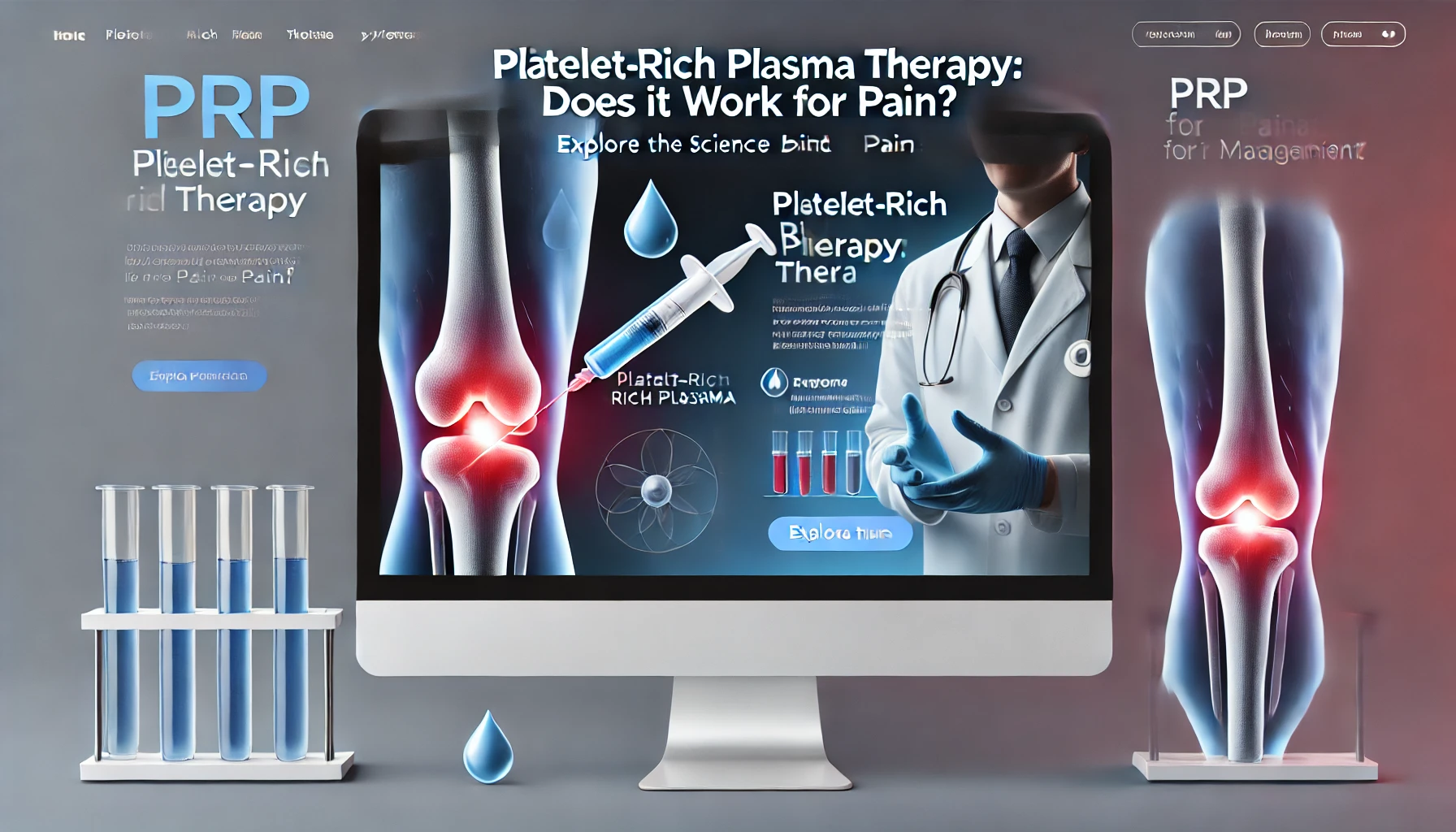Platelet-Rich Plasma (PRP) Therapy: Does It Work for Pain? 💉🩸

Written by Dr Sushpa Das
Introduction
Chronic pain is a debilitating condition that affects millions worldwide, significantly impacting quality of life. While traditional treatments like medications, physical therapy, and steroid injections provide relief, many patients seek regenerative therapies that heal rather than just mask pain. One such promising approach is Platelet-Rich Plasma (PRP) Therapy.
PRP therapy has gained popularity for treating musculoskeletal conditions, arthritis, and tendon injuries. But does it really work for pain management? In this blog, we explore the science behind PRP, its applications, effectiveness, and whether it is a reliable option for pain relief.
What is Platelet-Rich Plasma (PRP) Therapy? 🤔
PRP therapy is a regenerative medicine technique that utilizes a patient’s own blood to promote healing. The process involves:
1️⃣ Blood Collection: A small sample of blood is drawn from the patient.
2️⃣ Centrifugation: The blood is spun in a centrifuge to separate its components – red blood cells, white blood cells, plasma, and platelets.
3️⃣ Platelet-Rich Plasma Extraction: The plasma rich in platelets (which contain growth factors) is isolated.
4️⃣ Injection into the Affected Area: The PRP is injected into the painful or injured tissue, where it stimulates healing and tissue regeneration.
How Does PRP Work for Pain Relief? 🦾
PRP contains growth factors and cytokines that aid in tissue repair and reduce inflammation. The key mechanisms include:
🔹 Enhancing Cell Regeneration: PRP stimulates fibroblasts and stem cells, which accelerate tissue repair.
🔹 Reducing Inflammation: It helps modulate inflammatory responses, reducing chronic inflammation in joints and tendons.
🔹 Promoting Angiogenesis: PRP encourages blood vessel formation, improving oxygen and nutrient delivery to damaged tissues.
🔹 Collagen Production: Essential for tendon and ligament repair, collagen synthesis is boosted by PRP.
Conditions Where PRP is Used in Pain Medicine 💊
PRP therapy is increasingly used for various painful conditions, including:
🦵 Osteoarthritis (OA)
- PRP is widely used for knee osteoarthritis.
- Studies show it reduces pain and improves function by delaying cartilage degeneration.
- Some evidence suggests PRP is more effective than corticosteroid injections for long-term relief.
💪 Tendon & Ligament Injuries
- PRP is commonly used for conditions like tennis elbow (lateral epicondylitis), Achilles tendinitis, and rotator cuff injuries.
- It speeds up the healing of chronic tendinopathies where other treatments fail.
🦴 Lower Back Pain & Disc-Related Issues
- PRP is being explored for treating discogenic low back pain and facet joint arthritis.
- Injections into intervertebral discs and facet joints may provide relief by regenerating degenerative tissues.
🏌️ Sports Injuries & Muscle Tears
- Many athletes, including professional football and tennis players, use PRP to recover from muscle and ligament injuries faster.
- PRP promotes faster healing and reduces the need for surgical intervention.
Is PRP Effective? What Does Research Say? 📚
Several studies have evaluated PRP’s effectiveness in pain management. Here’s what the evidence suggests:
📌 Osteoarthritis:
- A 2019 meta-analysis found that PRP injections improved pain and function better than hyaluronic acid or corticosteroid injections in knee OA.
- Long-term follow-up shows sustained relief for up to 1-2 years after PRP therapy.
📌 Tendinopathies:
- PRP has shown promising results in treating chronic tendinitis, particularly in cases of tennis elbow and Achilles tendinopathy.
- Some studies report better outcomes than steroid injections, though results vary.
📌 Spinal Pain:
- Research on PRP for low back pain and disc degeneration is still in early stages.
- Some studies show reduced pain and improved function, but large-scale trials are needed.
🔎 While PRP shows promise, not all studies are conclusive, and individual responses vary. The quality of PRP preparation (single vs. double spin, leukocyte-rich vs. leukocyte-poor PRP) also affects results.
Pros and Cons of PRP Therapy ⚖️
✅ Advantages
✔️ Uses patient’s own blood – no risk of rejection.
✔️ Minimally invasive with low downtime.
✔️ Can delay or prevent surgery in some cases.
✔️ Less risk than steroids or NSAIDs, which have systemic side effects.
✔️ Can be combined with physical therapy for better outcomes.
❌ Limitations
❌ Not a quick fix – takes weeks to months to see results.
❌ Effectiveness varies – not all patients respond equally.
❌ Expensive – PRP is not always covered by insurance.
❌ Not standardized – Different preparation techniques yield different results.
❌ Multiple sessions may be required for optimal benefits.
Who Should Consider PRP Therapy? 🤷♂️
PRP is suitable for:
✅ Patients with mild to moderate osteoarthritis (before joint replacement becomes necessary).
✅ Individuals with chronic tendinopathy unresponsive to conventional treatments.
✅ Athletes or active individuals seeking natural healing instead of steroids.
✅ Patients looking for minimally invasive alternatives to surgery.
🚫 PRP may not be suitable for:
❌ Severe arthritis (bone-on-bone cases) where surgery is the best option.
❌ Patients on blood thinners, as these can affect PRP quality.
❌ Individuals with active infections or cancer.
Conclusion: Does PRP Work for Pain? 🤔✅
PRP therapy is a promising, natural approach for managing chronic pain, especially in conditions like osteoarthritis, tendinopathies, and sports injuries. While scientific evidence supports its use, its effectiveness depends on patient selection, PRP preparation techniques, and injection protocols.
For pain physicians, PRP is an exciting option to offer patients looking for regenerative treatments. However, more high-quality, large-scale studies are needed to establish standardized protocols.
If you’re considering PRP therapy for pain relief, consult a qualified pain physician to determine if it’s the right choice for you.
💬 Have you or your patients tried PRP for pain relief? What was the experience? Share your thoughts in the comments!
🔗 Interested in more updates on pain medicine? Follow Daradia for expert insights on interventional pain management!

